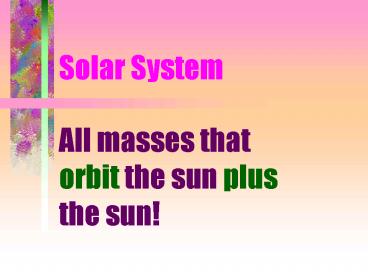Solar System - PowerPoint PPT Presentation
Solar System
No solid surfaces to preserve changes ... Convection (fluids; lower density blobs rise) Radiation (radiate energy, emitted and absorbed) ... – PowerPoint PPT presentation
Title: Solar System
1
Solar System
- All masses that orbit the sun plus the sun!
2
Solar System Contents
- Sun (most of the mass!)
- Planets and their satellites
- Asteroids (asteroid belt)
- Comets (Oort cloud)
- Gas and dust (all over!)
3
Terrestrial Planets
- Earthlike rocks, metals
- Solids and fluidlike materials
- Surfaces that record change
- Small sizes, but high densities
- Inside asteroid belt
4
Jovian Planets
- Jupiter-like Liquids gases
- No solid surfaces to preserve changes
- Large sizes, low densities, made mostly of
hydrogen and helium - Outside asteroid belt
5
Planet Models
- Mass spherical shape (Newtons law of
gravitation) - Radius (from angular size and distance)
- Bulk density (mass/volume) gt infer general
composition - Contain density layers (lowest, surface highest,
core)
6
Evolution of Planets
- Heat (energy flow)!
- Heat goes from hotter to cooler regions
- Drives internal surface change
- Eventually radiates into space
7
Energy Transfer
- Conduction (solids adjacent particles collide)
- Convection (fluids lower density blobs rise)
- Radiation (radiate energy, emitted and absorbed)
8
Internal Evolution
- Energy flow from core to surface to space
- Source Stored energy of formation, radioactive
decay - Results in volcanism, tectonics on solid surfaces
(terrestrial) convection in liquids gases
(Jovian)
9
External Evolution
- Impact cratering Solid objects from space, hit
at tens km/s - Bomb-like explosion many megatons (H-bomb!)
- Creates circular impact craters on solid
surfaces turbulent regions in liquids
PowerShow.com is a leading presentation sharing website. It has millions of presentations already uploaded and available with 1,000s more being uploaded by its users every day. Whatever your area of interest, here you’ll be able to find and view presentations you’ll love and possibly download. And, best of all, it is completely free and easy to use.
You might even have a presentation you’d like to share with others. If so, just upload it to PowerShow.com. We’ll convert it to an HTML5 slideshow that includes all the media types you’ve already added: audio, video, music, pictures, animations and transition effects. Then you can share it with your target audience as well as PowerShow.com’s millions of monthly visitors. And, again, it’s all free.
About the Developers
PowerShow.com is brought to you by CrystalGraphics, the award-winning developer and market-leading publisher of rich-media enhancement products for presentations. Our product offerings include millions of PowerPoint templates, diagrams, animated 3D characters and more.































